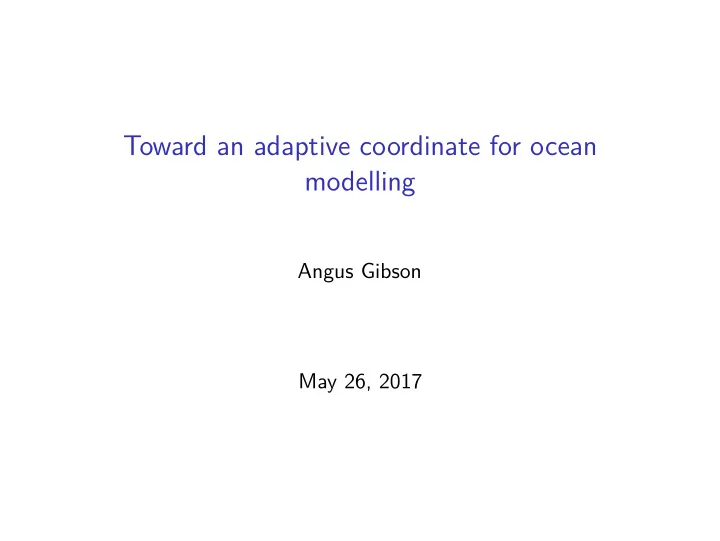

Toward an adaptive coordinate for ocean modelling Angus Gibson May 26, 2017
Overview
Motivation ◮ Isopycnal coordinate represents the interior well ◮ But requires mixed layer parameterisations ◮ z-star coordinate gives control over surface resolution ◮ Poor representation of overflows and isopycnal structure ◮ Combine benefits into a hybrid coordinate
ALE ◮ Arbitrary Lagrangian-Eulerian , composed of regridding and remapping steps ◮ Can define an arbitrary vertical grid with interfaces z k ( x , y , t ) through regridding ◮ (Actually more robust to give grid as thicknesses h k +1 / 2 ( x , y , t ))
HyCOM1 ◮ Adaptation of HyCOM, blending isopycnal/z-star ◮ Every interface has a target depth and density ◮ Actual depth of the interface is the deepest of the target and isopycnal depths ◮ Enforces resolution in the mixed layer ◮ Must be conservative to prevent surface boundary parameterisation problems ◮ i.e. unphysical mixing well into the interior
HyCOM1 Figure 1: topography intersecting z-star region
HyCOM1 ◮ Must be prescribed ahead of time ◮ Because the geopotential region is conservative, it has a negative impact on overflows ◮ Dense overflows (e.g. Denmark Strait) involve too much entrainment
Adaptive Coordinate
Introduction ◮ Developed in the coastal modelling community (e.g. Hofmeister et al., 2010) ∂ z k � � κ grid ∂ t − ∂ k k +1 / 2 ∂ k z k = H ◮ Involves two components: ◮ Optimisation of resolution within a single column ◮ Lateral smoothing/optimisation
Modification ∇ 2 σ H σ = ∂σ/∂ z ◮ To suit ocean modelling, we introduce a lateral neutral density optimisation ◮ Minimise curvature of neutral density on coordinate surfaces ◮ Gives neutral density surfaces over large scales
Parameters ◮ Vertical ◮ Near-surface scaling: κ s = α s z 0 / ( z 0 + z k ) ◮ Stratification scaling: κ N 2 = ( h k +1 � k ∂ k σ ) / ( D ∂ k σ ) ◮ (Shear scaling) ◮ Lateral ◮ Neutral density optimisation: source term involving ∇ 2 σ ◮ Smoothing: source term involving ∇ 2 h
Dense overflow Figure 2: State after 20 days in dense overflow
Open questions ◮ What do we want the coordinate to look like? ◮ How do we replicate near-surface resolution?
Recommend
More recommend